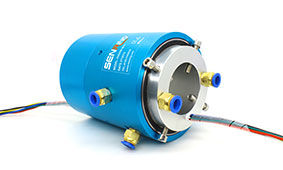How do I choose a Industrial Bus slip ring?
Choose a slip ring that is rated for the correct voltage and current. Make sure it has the right size and shape to fit your application. Check the material of construction, as some materials arebetter suited for certain environments than others. Consider the length of the shaft on which you will be mounting the slip ring, as well as any other special requirements you may have.
Choosing an industrial bus slip ring involves considering several key factors to ensure that the chosen industrial bus slip ring meets the specific requirements of the industrial bus system it will be integrated with.
Here are the steps to guide your selection process:

1. Identify Industrial Bus Specifications:
Communication Protocol: Determine the specific communication protocol utilized by the industrial bus system, such as Profibus, Modbus, CAN bus, DeviceNet, or Ethernet/IP.
Data Rate and Bandwidth: Understand the data rate and bandwidth requirements of the industrial bus system to ensure that the selected slip ring can effectively transmit data without compromising signal integrity.
2. Consider Environmental Conditions:
Operating Environment: Evaluate the environmental conditions in which the slip ring will operate, including factors such as temperature, humidity, and exposure to dust, moisture, or chemicals.
Choose a slip ring designed to withstand these conditions.
IP Rating: Ensure that the slip ring has an appropriate Ingress Protection (IP) rating suitable for the environmental conditions in which it will be installed.

3. Determine Electrical Requirements:
Number of Circuits: Identify the number of electrical circuits required for the industrial bus system. Ensure that the slip ring features the necessary number of circuits to accommodate power, signals,
and data transmission.
Voltage and Current Ratings: Match the voltage and current ratings of the slip ring to the requirements of the industrial bus system to prevent overloading and ensure safe and reliable power transmission.
4. Mechanical Considerations:
Size and Mounting: Consider the available space and mounting options for integrating the slip ring into the industrial bus system. Choose a size and mounting configuration that aligns with
the system's mechanical constraints.
Rotational Speed: Determine the rotational speed at which the slip ring will operate and ensure that the selected slip ring is rated for the intended speed to prevent excessive wear or performance issues.
5. Reliability and Maintenance:
Quality and Durability: Select a slip ring from a reputable manufacturer known for producing high-quality and durable products that can withstand the demands of industrial applications.
Maintenance Requirements: Consider the maintenance needs of the chosen slip ring, including access for inspection, cleaning, and potential replacement of components.
6. Consult with Manufacturers and Experts:
Manufacturer Guidance: Reach out to slip ring manufacturers or industry experts to discuss your specific requirements and obtain recommendations tailored to your industrial bus system.
By carefully considering these factors and consulting with relevant experts, you can choose an industrial bus slip ring that effectively integrates with your industrial bus system, providing reliable
and efficient communication and power transmission.
For more details on slip ring products, please view :https://www.senring.com/products.html
FAQ questions:
1.What is the current rating of a slip ring?
2.What is the use of through bore slip ring?
3.What is difference between slip ring and split ring?
4.What is capsule slip ring and is used for?
5.How to install through-hole conductive slip ring?
- Are Industrial Bus slip rings usually made of copper?
-

- 24-01-2024
- Yes, Industrial Bus slip rings are usually made of copper. Industrial Bus slip rings are not typically made entirely of copper. Instead, they often feature cop
- more+
- What material are Industrial Bus Slip Rings made of?
-

- 22-02-2024
- Industrial Bus Slip Rings are typically made of copper or aluminum, as these materials provide excellent electrical conductivity and durability. However, the sp
- more+
- What are the application fields of industrial bus slip rings?
-

- 11-12-2023
- The industrial bus slip ring is an electrical component responsible for connecting and transmitting energy and signals to rotating bodies. According to the tran
- more+
- How do I choose a Industrial Bus slip ring?
-

- 04-01-2024
- Choose a slip ring that is rated for the correct voltage and current. Make sure it has the right size and shape to fit your application. Check the material of c
- more+

 RESOURCES
RESOURCES GET A QUOTE
GET A QUOTE





